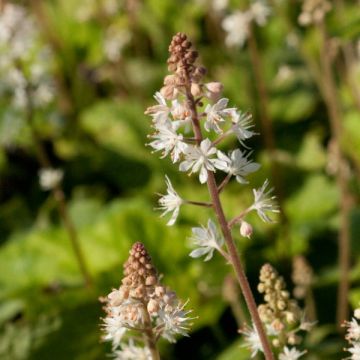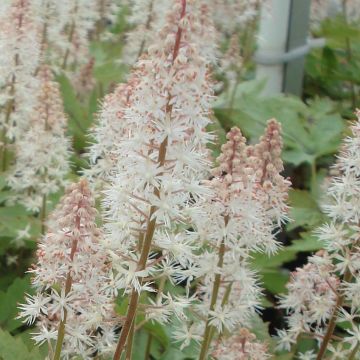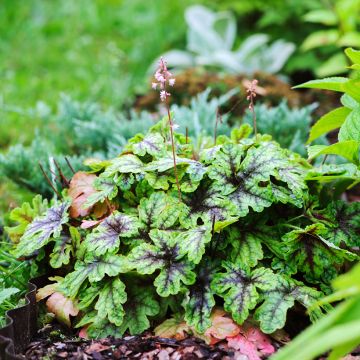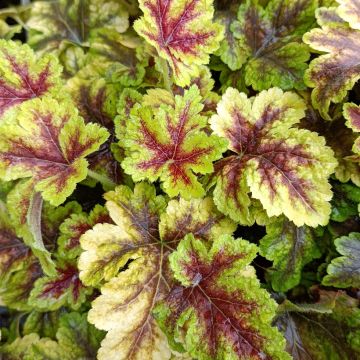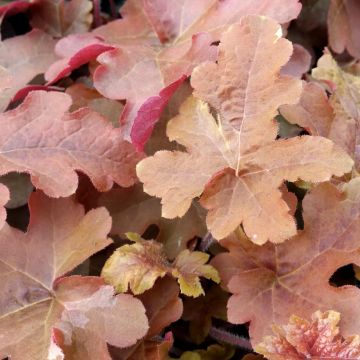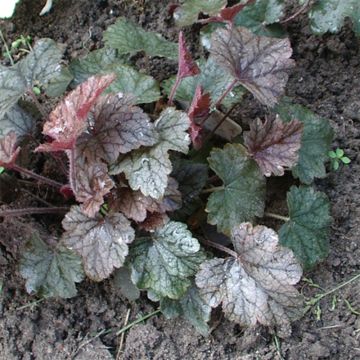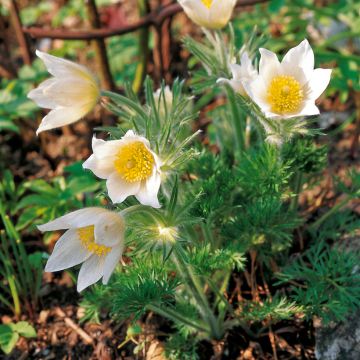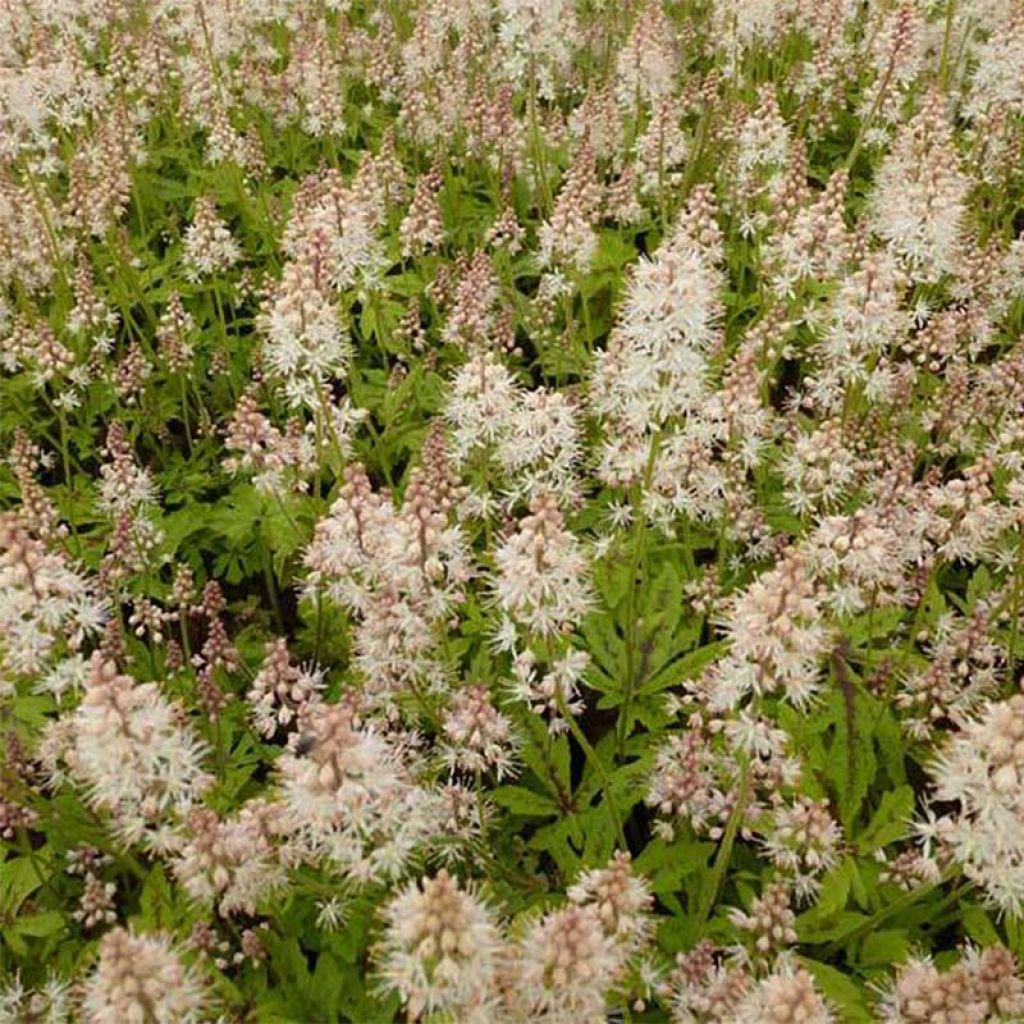

Tiarella x laciniata Arpeggio
Tiarella x laciniata Arpeggio
Tiarella x laciniata Arpeggio
Foamflower
Why not try an alternative variety in stock?
View all →This plant carries a 12 months recovery warranty
More information
We guarantee the quality of our plants for a full growing cycle, and will replace at our expense any plant that fails to recover under normal climatic and planting conditions.
From €5.90 for pickup delivery and €6.90 for home delivery
Express home delivery from €8.90.

Does this plant fit my garden?
Set up your Plantfit profile →
Description
Tiarella 'Arpeggio' is a hybrid Tiarella variety distinguished by a beautiful foliage reminiscent of some maples. It forms a mound of deeply cut and lobed light green leaves, marked with a darker central spot, which take on pretty pink-purple tones at the first cold. It also seduces with its spring and feathery flowering, in the form of spikes of very pale pink turning white. This very hardy perennial plant, mostly evergreen, spreads laterally to form an excellent groundcover in damp shade.
Tiarella 'Arpeggio' belongs to the Saxifragaceae family. This horticultural hybrid is likely derived from the species Tiarella trifoliata var. laciniata, with remarkably finely cut foliage. It is a cousin of Heuchera native to North American undergrowth. The 'Arpeggio' variety will reach 30 cm (12in) in all directions, forming a spreading tuft with evergreen and colorful foliage, its first asset. Its palmate and deeply lobed leaves measure 10 cm (4in) in length and are nicely embossed and marked with a dark central spot, variable depending on the seasons, from dark green to purplish on a light green background. In winter, they turn almost entirely pink-red. In April-May, the flowers appear, densely distributed in brush on stems of about 30 cm (12in) in height, offering a beautiful gradient from pale pink to white, depending on their discoloration over time. The flowering is particularly long for the species, lasting from spring to early summer. This plant spreads by stolons and can quickly cover a large area.
In the wild, Tiarellas are generally found in wooded or mountainous environments, in damp and humus-rich soil. Tiarella 'Arpeggio' will naturally find its place in wet undergrowth alongside ferns, hostas, Impatiens balfouri, Solomon's seals, and astilbes. It can also be used as a waterside plant, to accompany Rodgersia. It will also thrive in shaded pots or containers. It should be planted in a well-drained potting mix without excessive fertilizer, with watering monitored in summer. Pots will need winter protection.
The flower buds are formed during summer, but they will only develop and bloom after being exposed to a minimum of 10 weeks of cold temperatures the following year. Cold is therefore necessary for the flowering of this perennial.
Report an error about the product description
Tiarella x laciniata Arpeggio in pictures
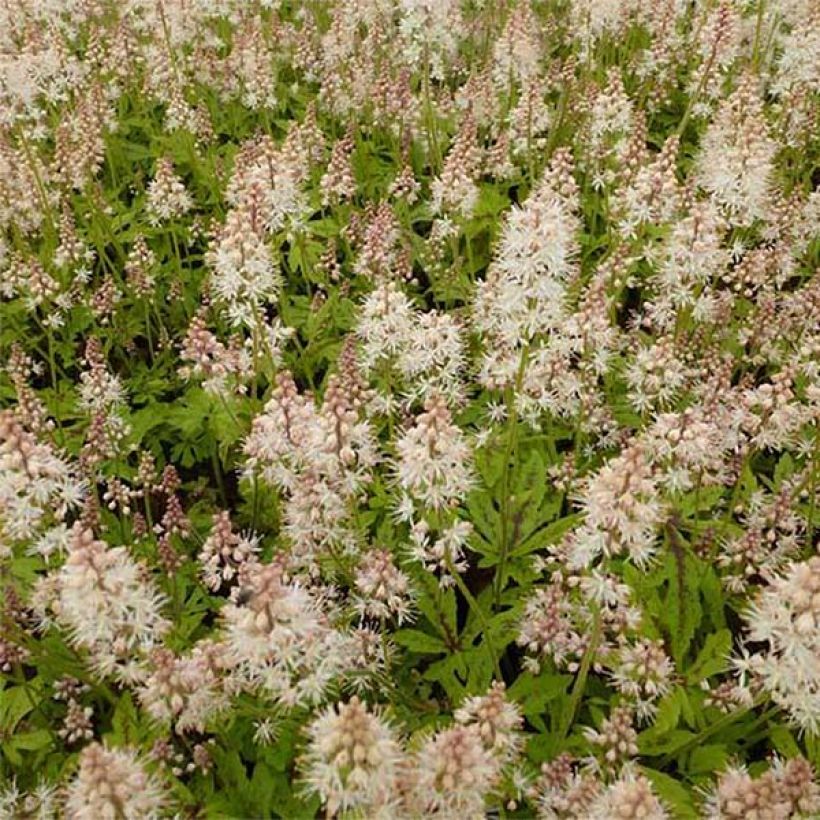

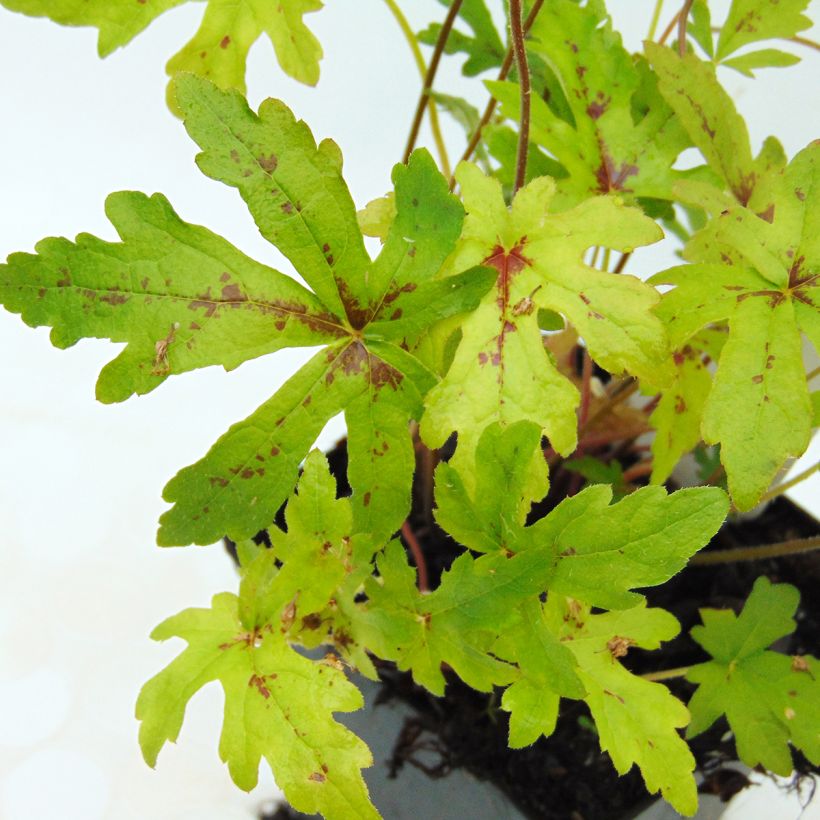

Flowering
Foliage
Plant habit
Botanical data
Tiarella
x laciniata
Arpeggio
Saxifragaceae
Foamflower
Cultivar or hybrid
Other Tiarellas and Heucherellas
Planting and care
Easy to maintain, Tiarella 'Arpeggio' thrives in all moist to wet, well-drained, neutral to acidic soils. It can be planted in partial shade or dense shade (although the foliage colour may appear duller). It must be protected from full sun and excessive winter moisture. Plant it in loose soil that retains moisture, lightening it with coarse sand if it is too heavy, and consider using mulch. It does not tolerate very hot conditions. This perennial seems to tolerate dry shade under trees and bushes. It requires little maintenance and pruning is not necessary unless the foliage is damaged or to rejuvenate the plant.
Planting period
Intended location
Care
-
, onOrder confirmed
Reply from on Promesse de fleurs
Spring flowering perennials
Haven't found what you were looking for?
Hardiness is the lowest winter temperature a plant can endure without suffering serious damage or even dying. However, hardiness is affected by location (a sheltered area, such as a patio), protection (winter cover) and soil type (hardiness is improved by well-drained soil).

Photo Sharing Terms & Conditions
In order to encourage gardeners to interact and share their experiences, Promesse de fleurs offers various media enabling content to be uploaded onto its Site - in particular via the ‘Photo sharing’ module.
The User agrees to refrain from:
- Posting any content that is illegal, prejudicial, insulting, racist, inciteful to hatred, revisionist, contrary to public decency, that infringes on privacy or on the privacy rights of third parties, in particular the publicity rights of persons and goods, intellectual property rights, or the right to privacy.
- Submitting content on behalf of a third party;
- Impersonate the identity of a third party and/or publish any personal information about a third party;
In general, the User undertakes to refrain from any unethical behaviour.
All Content (in particular text, comments, files, images, photos, videos, creative works, etc.), which may be subject to property or intellectual property rights, image or other private rights, shall remain the property of the User, subject to the limited rights granted by the terms of the licence granted by Promesse de fleurs as stated below. Users are at liberty to publish or not to publish such Content on the Site, notably via the ‘Photo Sharing’ facility, and accept that this Content shall be made public and freely accessible, notably on the Internet.
Users further acknowledge, undertake to have ,and guarantee that they hold all necessary rights and permissions to publish such material on the Site, in particular with regard to the legislation in force pertaining to any privacy, property, intellectual property, image, or contractual rights, or rights of any other nature. By publishing such Content on the Site, Users acknowledge accepting full liability as publishers of the Content within the meaning of the law, and grant Promesse de fleurs, free of charge, an inclusive, worldwide licence for the said Content for the entire duration of its publication, including all reproduction, representation, up/downloading, displaying, performing, transmission, and storage rights.
Users also grant permission for their name to be linked to the Content and accept that this link may not always be made available.
By engaging in posting material, Users consent to their Content becoming automatically accessible on the Internet, in particular on other sites and/or blogs and/or web pages of the Promesse de fleurs site, including in particular social pages and the Promesse de fleurs catalogue.
Users may secure the removal of entrusted content free of charge by issuing a simple request via our contact form.
The flowering period indicated on our website applies to countries and regions located in USDA zone 8 (France, the United Kingdom, Ireland, the Netherlands, etc.)
It will vary according to where you live:
- In zones 9 to 10 (Italy, Spain, Greece, etc.), flowering will occur about 2 to 4 weeks earlier.
- In zones 6 to 7 (Germany, Poland, Slovenia, and lower mountainous regions), flowering will be delayed by 2 to 3 weeks.
- In zone 5 (Central Europe, Scandinavia), blooming will be delayed by 3 to 5 weeks.
In temperate climates, pruning of spring-flowering shrubs (forsythia, spireas, etc.) should be done just after flowering.
Pruning of summer-flowering shrubs (Indian Lilac, Perovskia, etc.) can be done in winter or spring.
In cold regions as well as with frost-sensitive plants, avoid pruning too early when severe frosts may still occur.
The planting period indicated on our website applies to countries and regions located in USDA zone 8 (France, United Kingdom, Ireland, Netherlands).
It will vary according to where you live:
- In Mediterranean zones (Marseille, Madrid, Milan, etc.), autumn and winter are the best planting periods.
- In continental zones (Strasbourg, Munich, Vienna, etc.), delay planting by 2 to 3 weeks in spring and bring it forward by 2 to 4 weeks in autumn.
- In mountainous regions (the Alps, Pyrenees, Carpathians, etc.), it is best to plant in late spring (May-June) or late summer (August-September).
The harvesting period indicated on our website applies to countries and regions in USDA zone 8 (France, England, Ireland, the Netherlands).
In colder areas (Scandinavia, Poland, Austria...) fruit and vegetable harvests are likely to be delayed by 3-4 weeks.
In warmer areas (Italy, Spain, Greece, etc.), harvesting will probably take place earlier, depending on weather conditions.
The sowing periods indicated on our website apply to countries and regions within USDA Zone 8 (France, UK, Ireland, Netherlands).
In colder areas (Scandinavia, Poland, Austria...), delay any outdoor sowing by 3-4 weeks, or sow under glass.
In warmer climes (Italy, Spain, Greece, etc.), bring outdoor sowing forward by a few weeks.

































